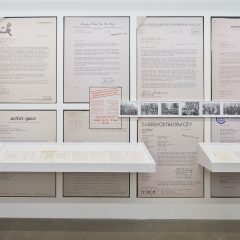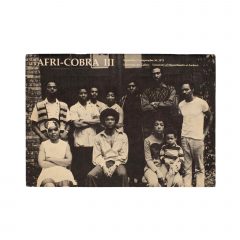Tim Hawkinson’s signature whimsy is somewhat limited at his work on view at Blum & Poe in Los Angeles (closing today). I’m not saying the show wasn’t interesting or that the work was a bust. I’m just saying, the biggest pieces in the show were a bit ponderous.
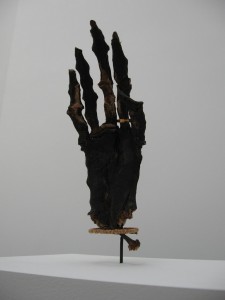
But for all that, any show by Tim Hawkinson is worth the effort of getting there and looking. His unstoppable sense of compulsive experimentation and brio mechanics are still there. And the surprises of materials and wry humor carry the day for a show of 11 pieces, 10 of them dated 2010.
The smaller pieces are where the strength of the show lies. Apples and Bananas, a sculpture of a burnt-looking hand, is made of fruits, twist ties, bread tabs and bronze. The inventiveness of materials combined with the look of decayed and burnt flesh is shocking. The everyday rot we experience in fruit suddenly takes on a broader meaning.
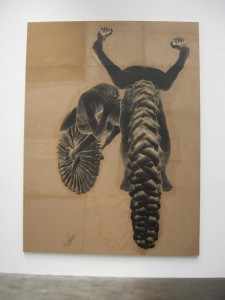
In Bike, Hawkinson photo collages body parts to create a motorcycle. The up-close discovery of fingers as the complex, woven tire-tread pattern is remarkable. I immediately recalled a Jacques Lipchitz lecture I had attended around 1970 in which he examined the brilliance of the concept of the wheel in terms of legs as spokes.
The show features two enormous pieces that are clearly the centerpieces of the show. They are both disappointments.
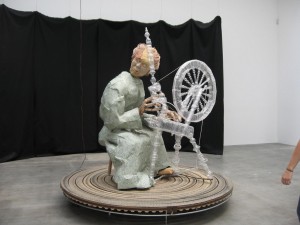
Orrery (the word for a model of solar system with its spinning planets) gets high points on obsession with spinning and wheels. But the woman’s form is ponderous (and sort of bad Anne Chu), without the usual Hawkinson fascination with the body and how it works–and how vulnerable it is. What is vulnerable here is Mother Earth with her head in orbit. It’s a recycling piece, made of plastic bottles and shopping bags. I get the pun on recycling, but somehow I was more wowed by the scale and mechanics than the whole.
The piece is theatrical and heroic–more suitable for a public sculpture, for a building lobby. The woman’s slow-spinning head appears to be powered by the same mechanism that powers the glorious platform of spinning rings, which do indeed evoke an orrery. But even these rings can’t raise this piece to the stratasphere. I did like the optic print of the woman’s dress–so convincing that I had to ask whether the rings on the dress were really spinning or just an illusion. The general sense I got is of a piece thoroughly planned in advance, without enough room for exploration (isn’t that what commissioned public sculpture is all about?)
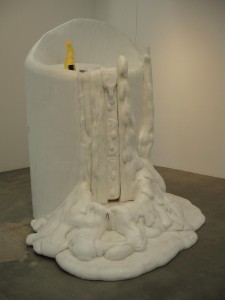
The other blockbuster sized piece is Candle, a sort of inverted, earthbound rocketship.
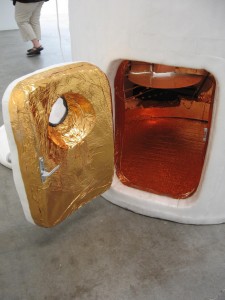
The exterior never manages to achieve the sense of flow of wax that appears to be its mechanical mission. The mechanical wax-fall is hokey but not quite hokey enough. I did like the little emergency-blanket-padded door, opened to reveal the interior mechanism–a chamber for the rocketeer or maybe the candle gnome. The space-age quality of the blanket is a swell contrast to the machinery, and taken together they suggest the limits of humanity.


